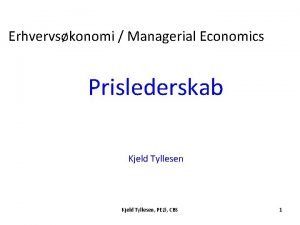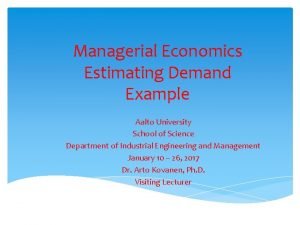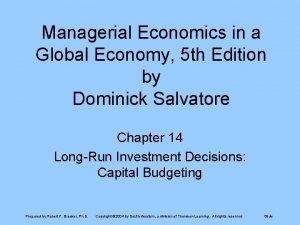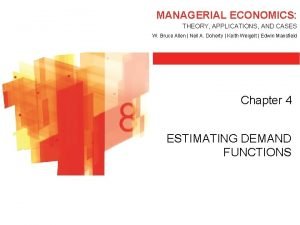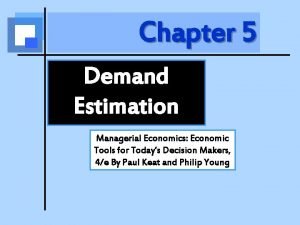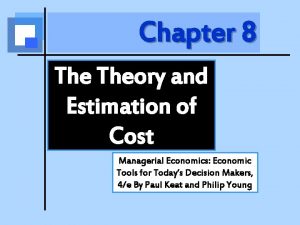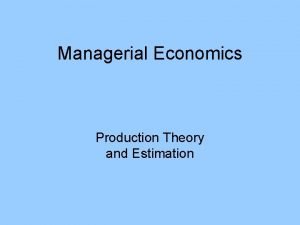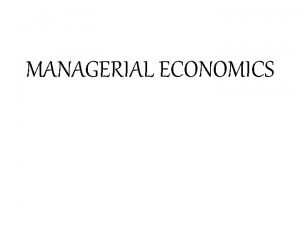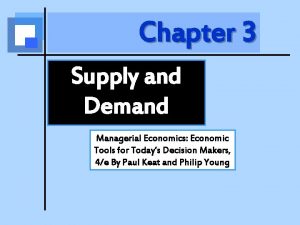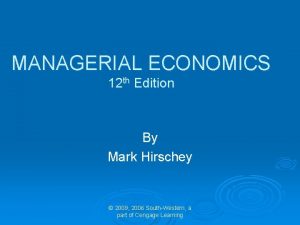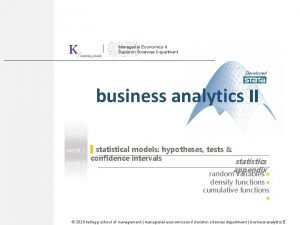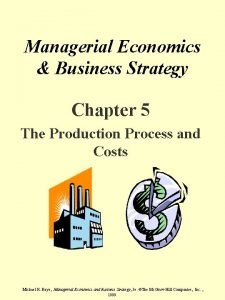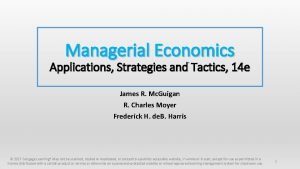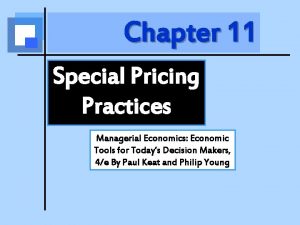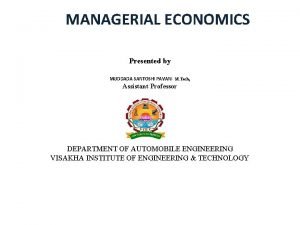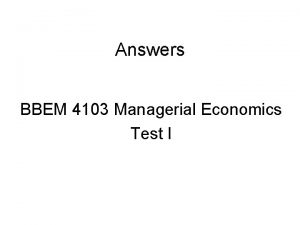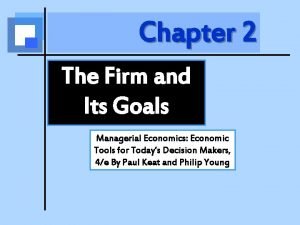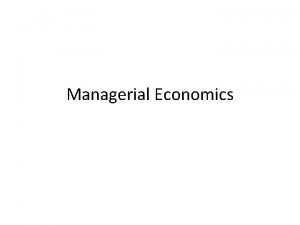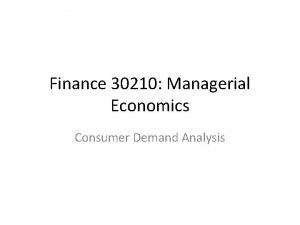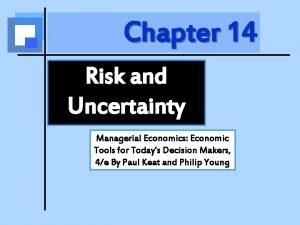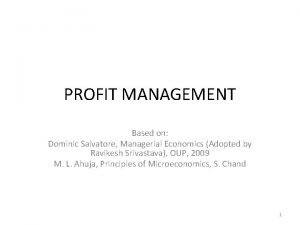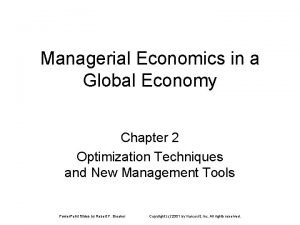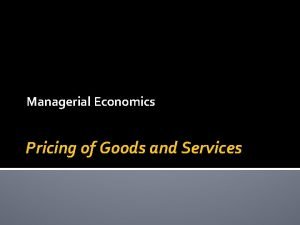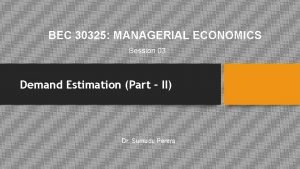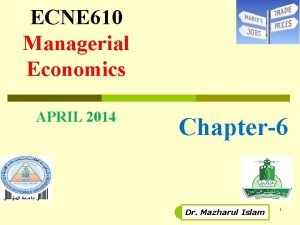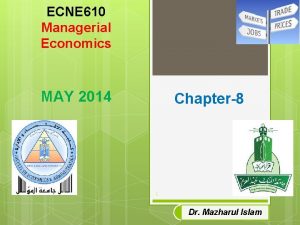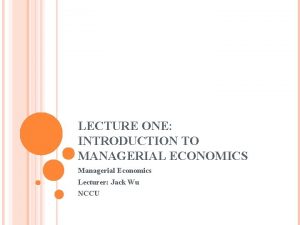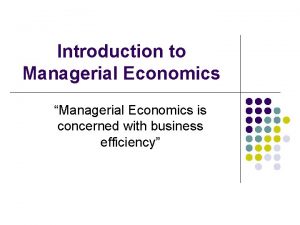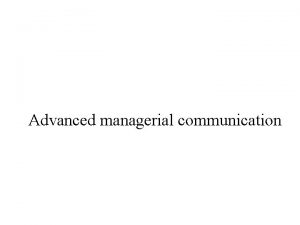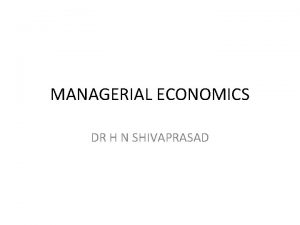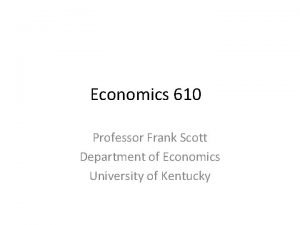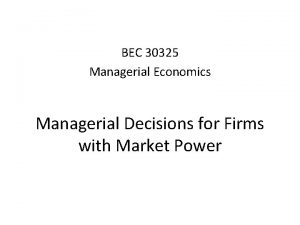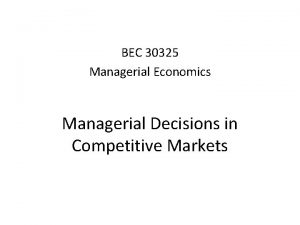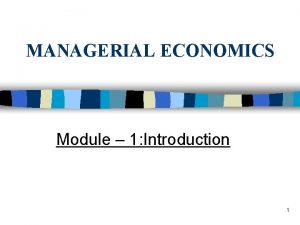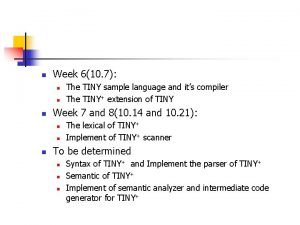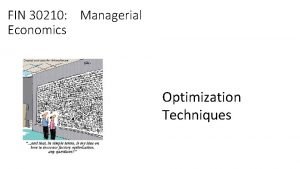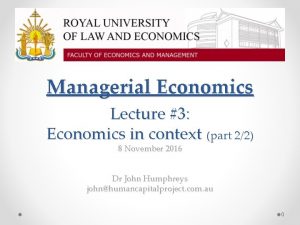ECNE 610 Managerial Economics Week 5 APRIL 2014









































- Slides: 41

ECNE 610 Managerial Economics Week 5 APRIL 2014 Chapter-4 1 Dr. Mazharul Islam

2 DEMAND ELASTICITY 4 5 Dr. Mazharul Islam

3 Lesson Objectives q define and measure elasticity. q apply concepts of price elasticity, crosselasticity, and income elasticity. q understand determinants of elasticity. q show elasticity affects business revenue. Dr. Mazharul Islam

4 Elasticity: In economics, elasticity is the measurement of how changing one economic variable affects others. Example: "If I lower the price of my product, how much more will I sell? " Dr. Mazharul Islam

5 Price elasticity of demand: The responsiveness of the quantity demanded of a good to a 1% change in its price when all other influences on buying plans remain the same. Here, P = initial price, Qd = initial quantity demanded, P′ = new price, Q′d = new quantity demanded, = change Dr. Mazharul Islam

6 Point elasticity: It measured elasticity at a given point of a demand (or a supply) curve. The point elasticity of a linear demand function can be expressed as: Dr. Mazharul Islam

7 Categories of elasticity The price elasticity of demand can be divided into general categories depending on how responsive three quantity demanded is to a change in price. If the percent change in quantity demanded is smaller than the percent change in price, the resulting price elasticity has an absolute value between 0 and 1. 0 demand is inelastic. So we can write: 0 < Ep < 1 Dr. Mazharul Islam

8 Inelasticity Demand $1. 10 b Price per taco 0. 90 a D 0 Thousands per day 95 105 Dr. Mazharul Islam

9 Unit Elastic Demand the percent change in quantity demanded just equals the percent change in price a price elasticity with an absolute value of 1. 0 unitelastic demand. Price per unit If E D= $10 6 0 1 a b D" 60 100 Quantity period Dr. Mazharul Islam

10 Elastic Demand If the percent change in quantity demanded exceeds the percent change in price, the resulting price elasticity has an absolute value exceeding 1. 0 demand is said to be elastic. Dr. Mazharul Islam

11 Elastic Demand $1. 10 a b Price per taco 0. 90 0 D 65 105 Thousands per day Dr. Mazharul Islam

12 Elasticity varies along a linear demand curve. Dr. Mazharul Islam

13 Perfectly Inelastic Demand If no change in quantity demanded with the change in price a price elasticity with an absolute value of 0. 0 perfectly inelastic demand. Dr. Mazharul Islam

14 Perfectly Elastic Demand If the percentage change in the quantity demanded is infinitely large when the price barely changes a price elasticity with an absolute value of perfectly elastic demand. Dr. Mazharul Islam

15 Summary of the Categories of elasticity of Demand is Elastic if : Ep > 1 Demand is inelastic if : 0 < Ep < 1 Demand is unit elastic if : Ep = 1 Demand is perfect elastic: Ep = ∞ Demand is perfect inelastic: Ep = 0 Dr. Mazharul Islam

16 The Factors that Influence the Elasticity of Demand §The availability and closeness of substitutes goods. §The proportion of income spent on the good. §The time elapsed since a price change. Dr. Mazharul Islam

17 The Factors that Influence the Elasticity of Demand §The availability and closeness of substitutes. The greater and closer the substitutes for a good or service, the more elastic is the demand for the good or service. Because consumers could choose its substitutes easily. The demand for a good is elastic if a substitute for it is easy to find. The demand for a good is inelastic if a substitute for it is hard to find. Dr. Mazharul Islam

18 The Factors that Influence the Elasticity of Demand §The proportion of income spent on the good The greater the proportion of income consumers spend on a good, the larger is the elasticity of demand for that good. Because a change in the price of such a good has an affect consumers' budget with a bigger magnitude. Consumers will respond by cutting back more on these product when price increases. Dr. Mazharul Islam

19 The Factors that Influence the Elasticity of Demand §Time Elapsed Since Price Change The longer the time after the price change, the more elastic will be the demand. It is because consumers are given more time to carry out their actions. The longer the adjustment period, increase the consumers’ ability to substitute away from relatively higher-priced products toward lower-priced substitutes. Dr. Mazharul Islam

20 Initial price = $1. 00 Dw = the demand curve one week after the price change Dm = one month after Dy, = one year after. $1. 25 $1. 00 Dw shows that one week after the price increase, the quantity demanded has not changed much – in this case from 100 to 95. Conversely, after one month, the quantity demanded has declined to 75, and after one year to 50 per day. Price per unit Suppose the price now increases to $1. 25. The more time for consumers to respond to price increase, the greater the reduction in quantity demanded. Dy Dw 0 50 75 95 100 Dm Quantity period Note that among these demand curves, the flatter the demand curve, the more price elastic the demand. Dr. Mazharul Islam

21 Cross Elasticity of Demand Cross-elasticity of demand: The responsiveness of the demand for one good to changes in the price of another good is called the cross-price elasticity of demand In simplest term: the percentage change in quantity consumed of one product as a result of a 1 percent change in the price of a related product Dr. Mazharul Islam

22 Cross Elasticity of Demand Cross elasticity of demand Its numerical value can be positive, negative, or zero depending on the nature of goods. Ø If goods are substitutes, the cross elasticity of demand is positive Ø If goods are complements, the cross elasticity of demand is negative Ø If goods are unrelated, the cross elasticity of demand is zero. Dr. Mazharul Islam

23 Income Elasticity of Demand Income elasticity of demand the percentage change in quantity demanded caused by a 1 percent change in income. In simplest terms the percent change in the demand of one good divided by the percent change in income. Percentage change in quantity demanded income elasticity of demand = -------------------------- Percentage change in income Dr. Mazharul Islam

24 More Elasticities of Demand Income elasticity of demand Ø If the income elasticity of demand is greater than 1, demand is income elastic and the good is a normal good (luxury/superior goods) Ø If the income elasticity of demand is greater than zero but less than 1, demand is income inelastic and the good is a normal good (necessity goods) Ø If the income elasticity of demand is less than zero (negative) the good is an inferior good. Dr. Mazharul Islam

25 Elasticity of Supply The elasticity of supply measures the responsiveness of the quantity supplied to a change in the price of a good when all other influences on selling plans remain the same. In simplest term, The price elasticity of supply equals the percent change in quantity supplied divided by the percent change in price. Percentage change in quantity supplied Elasticity of supply =-----------------------------Percentage change in price Dr. Mazharul Islam

26 Elasticity of Supply Note that the categories of supply elasticity same as demand elasticity. If supply elasticity is less than 1. 0, supply is inelastic If it equals 1. 0, supply is unit elastic If it exceeds 1. 0, supply is elastic If it is infinity, supply is perfectly elastic If it is zero, supply is perfectly inelastic. Dr. Mazharul Islam

27 The Factors that Influence the Elasticity of Supply The elasticity of supply depends on <Resource availability and substitution possibilities. <Time frame for supply decision. <Number of Producers <Easy of storing stock <Improvement in Technology <Stock of finished goods <Increase in cost of production as compared to output. Dr. Mazharul Islam

28 The Factors that Influence the Elasticity of Supply Resource availability and substitution possibilities q. The easier it is to substitute among the resources used to produce a good or service, the greater is its elasticity of supply. Alternatively also true. q. So the greater the availability of resources, the supply of goods and services will be elastic and the smaller the availability, the supply will be inelastic. Dr. Mazharul Islam

29 q. Time frame for supply decision Supply becomes more elastic over time producers adjust to price changes Sw Sm Sy Price per unit Sw is the supply curve when the period of adjustment is a week. In this situation, the higher price does not elicit much of a response in quantity supplied because firms have little time to adjust supply curve is inelastic if the price increases from $1. 00 to $1. 25 as Sm is the supply curve when the adjustment period is one month. Here the firms have a greater 0 ability to vary output supply is 100 140 200 Quantity period 110 more elastic Supply is even more elastic when the adjustment period is a year as shown by Sy Dr. Mazharul Islam

30 The Factors that Influence the Elasticity of Supply q Number of producers More producers mean that the output can be increased more easily. Thus supply is more elastic. q Easy of storing stocks If goods can be stocked with ease and have a long shelf life, the supply will be elastic, otherwise inelastic. For example perishable goods such as fresh flowers, vegetables have comparatively inelastic supply because it is difficult to store them for longer periods. Dr. Mazharul Islam

31 The Factors that Influence the Elasticity of Supply q Improvement in Technology In industries where there is a rapid improvement in technology, the price elasticity of supply of such goods will be more elastic as compared to industries where there is not much improvement in technology. q Stock of finished goods In industries where there are high inventories/stocks of finished goods, the suppliers can easily supply more as the price rises. Thus, the price elasticity of supply for these goods will be elastic. Dr. Mazharul Islam

32 The Factors that Influence the Elasticity of Supply q. Increase in cost of production as compared to output In cases where there is a significant increase in cost of production when output is increased, supply is inelastic. This is because suppliers will have to do a significant investment in order to increase the output. It will take time and some suppliers may be hesitant in doing so. Dr. Mazharul Islam

Elasticity and Total Revenue 33 Total revenue (TR) is the total amount of money that received by selling goods or services. That means TR equals the price of the good multiplied by the quantity sold TR = p x q What happens to total revenue when price changes? Dr. Mazharul Islam

Elasticity and Total Revenue 34 Chapter Four The relationship between price and revenue depends on elasticity Why? By itself, a price fall will reduce receipts … BUT because the demand curve is downward sloping, the drop in price will also increase quantity demanded Q: which effect will be stronger? Dr. Mazharul Islam

Elasticity and Total Revenue 35 If demand is elastic: A given percentage rise in price brings a larger percentage decrease in the quantity demanded. Total revenue decreases. If demand is inelastic: A given percentage rise in price brings a smaller percentage decrease in the quantity demanded. Total revenue increases. If demand is unit elastic: No change in total revenue Dr. Mazharul Islam

Elasticity and Total Revenue 36 Total revenue test: If price and total revenue change in the opposite directions, demand is elastic. If a price change leaves total revenue unchanged, demand is unit elastic. If price and total revenue change in the same direction, demand is inelastic. Dr. Mazharul Islam

37 Price per unit Consider a movement from point a to point b on the demand curve. At point a, TR = 100*90 = 9000. At point b, TR = 200*80 = 16000. So is the demand of good is elastic then decrease in price will led higher TR. (a) Demand Price Elasticity $100 90 80 70 60 50 40 30 20 10 a b c d 0 500 D 800 900 1, 000 Quality period (b) Total Revenue TR = p x q $25, 000 Total revenue Between points d and e on the lower end, calculate TR and check what happens. 100 200 e Total revenue 0 Quantity period 500 Dr. Mazharul Islam 1, 000

Elasticity and Total Revenue 38 Marginal Chapter Four revenue: the change in total revenue resulting from changing quantity by one unit

Elasticity and Total Revenue marginal revenue curve is twice as steep as the demand curve Chapter Four 39

Elasticity and Total Revenue at the point where marginal revenue crosses the X-axis, the demand curve is unitary elastic and total revenue reaches a maximum Chapter Four 40

41 Do you have any question? Dr. Mazharul Islam
 Engineering and managerial economics
Engineering and managerial economics Managerial economics nature and scope
Managerial economics nature and scope Prislederskab
Prislederskab Fundamentals of managerial economics
Fundamentals of managerial economics Cost theory and estimation
Cost theory and estimation Example of managerial economics
Example of managerial economics Managerial economics meaning and definition
Managerial economics meaning and definition Managerial economics in a global economy
Managerial economics in a global economy Game theory managerial economics
Game theory managerial economics Managerial economics: theory, applications, and cases
Managerial economics: theory, applications, and cases Nature and scope of econometrics
Nature and scope of econometrics Regression analysis in managerial economics
Regression analysis in managerial economics Estimation of cost function in managerial economics
Estimation of cost function in managerial economics Production theory and estimation
Production theory and estimation Concepts of managerial economics
Concepts of managerial economics Managerial economics
Managerial economics Demand and supply analysis in managerial economics
Demand and supply analysis in managerial economics Incremental reasoning
Incremental reasoning Managerial economics 12th edition mark hirschey
Managerial economics 12th edition mark hirschey Managerial economics and decision sciences
Managerial economics and decision sciences Managerial economics chapter 5
Managerial economics chapter 5 Managerial economics applications strategy and tactics
Managerial economics applications strategy and tactics Transfer pricing in managerial economics
Transfer pricing in managerial economics Managerial economics
Managerial economics Managerial economics questions and answers
Managerial economics questions and answers Managerial economics
Managerial economics The goal of the firm
The goal of the firm Managerial economics
Managerial economics Opportunity cost principle
Opportunity cost principle Managerial economics demand analysis
Managerial economics demand analysis Managerial economics define
Managerial economics define Uncertainty vs risk
Uncertainty vs risk Profit management in managerial economics
Profit management in managerial economics Managerial economics is called as
Managerial economics is called as Pricing methods in managerial economics
Pricing methods in managerial economics Managerial economics
Managerial economics Demand estimation in managerial economics
Demand estimation in managerial economics Demand estimation
Demand estimation Week by week plans for documenting children's development
Week by week plans for documenting children's development Nia 930
Nia 930 Mgt 610
Mgt 610 Ieee 610
Ieee 610


